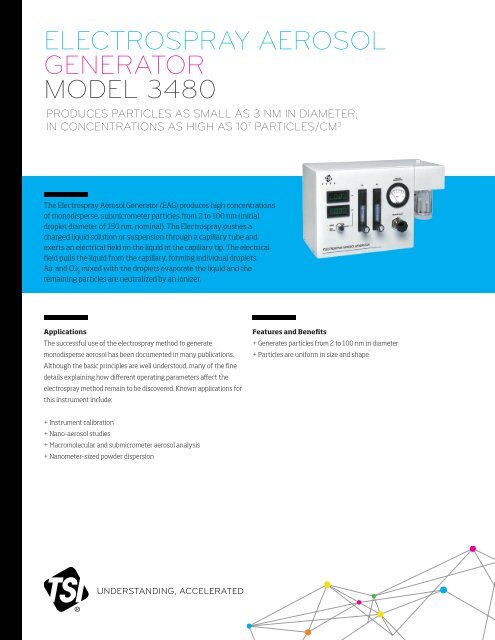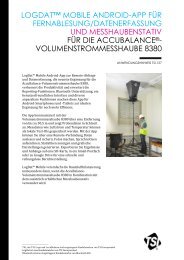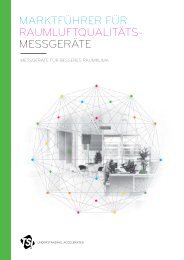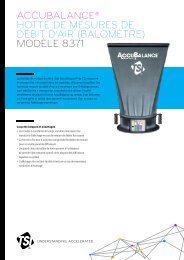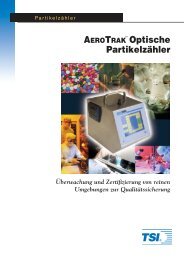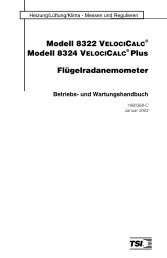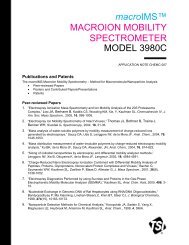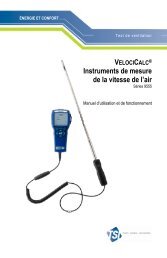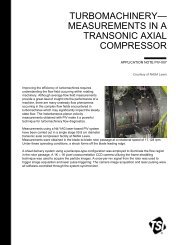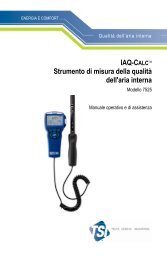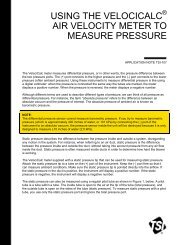ELECTROSPRAY AEROSOL GENERATOR MODEL 3480 - TSI
ELECTROSPRAY AEROSOL GENERATOR MODEL 3480 - TSI
ELECTROSPRAY AEROSOL GENERATOR MODEL 3480 - TSI
Create successful ePaper yourself
Turn your PDF publications into a flip-book with our unique Google optimized e-Paper software.
<strong>ELECTROSPRAY</strong> <strong>AEROSOL</strong><br />
<strong>GENERATOR</strong><br />
<strong>MODEL</strong> <strong>3480</strong><br />
PRODUCES PARTICLES AS SMALL AS 3 NM IN DIAMETER,<br />
IN CONCENTRATIONS AS HIGH AS 10 7 PARTICLES/CM 3<br />
The Electrospray Aerosol Generator (EAG) produces high concentrations<br />
of monodisperse, submicrometer particles from 2 to 100 nm (initial<br />
droplet diameter of 150 nm, nominal). The Electrospray pushes a<br />
charged liquid solution or suspension through a capillary tube and<br />
exerts an electrical field on the liquid at the capillary tip. The electrical<br />
field pulls the liquid from the capillary, forming individual droplets.<br />
Air and CO 2 mixed with the droplets evaporate the liquid and the<br />
remaining particles are neutralized by an ionizer.<br />
Applications<br />
The successful use of the electrospray method to generate<br />
monodisperse aerosol has been documented in many publications.<br />
Although the basic principles are well understood, many of the fine<br />
details explaining how different operating parameters affect the<br />
electrospray method remain to be discovered. Known applications for<br />
this instrument include:<br />
+ Instrument calibration<br />
+ Nano-aerosol studies<br />
+ Macromolecular and submicrometer aerosol analysis<br />
+ Nanometer-sized powder dispersion<br />
UNDERSTANDING, ACCELERATED<br />
Features and Benefits<br />
+ Generates particles from 2 to 100 nm in diameter<br />
+ Particles are uniform in size and shape
SPECIFICATIONS<br />
<strong>ELECTROSPRAY</strong> <strong>AEROSOL</strong> <strong>GENERATOR</strong><br />
<strong>MODEL</strong> <strong>3480</strong><br />
Settings and Requirments<br />
Particle generation rate >10 7 particles/cm 3<br />
Liquid conductivity 0.2 S/m nominal<br />
Liquid flow rate 50 to 100 nL/min<br />
Particle size range 100 nm<br />
Initial droplet diameter 150 nm<br />
Differential pressure 0 to 5 psi (3.0 psi nominal)<br />
Air flow 0.2 to 2.5 L/min (1 L/min nominal)<br />
CO 2 flow 0.05 to 0.5 L/min (0.1 L/min nominal)<br />
Power Specifications<br />
Charger Po-210, 5 millicurie*<br />
Voltage range +0.5 to +3.5 kV (2 kV nominal,<br />
negative high-voltage<br />
module available)<br />
Current range 0 to 2000 nA (180 to 320<br />
nA nominal)<br />
Power requirements 85 to 264 VAC, 50 to 60 Hz,<br />
25 W maximum<br />
Product Specifications<br />
Dimensions 20.3 x 40.4 x 25.7 cm<br />
(8.0 x 15.9 x 10.1 in.)<br />
Weight: 6.8 kg (15 lb)<br />
Operation<br />
The operator places a standard centrifuge vial con taining a sample solution<br />
inside a cylindrical pressure vessel. The vessel ac com modates a capillary and<br />
a high-voltage platinum wire, both of which are im mersed in the solution.<br />
Maintaining a differential pressure moves the solution through the capillary.<br />
An electric field induces a charge on the solution at the capillary tip and<br />
acts on the induced charge to form ultrafine drop lets that are mixed with<br />
clean air and CO . The gas flow transports the droplets to the neutralization<br />
2<br />
chamber. The highly charged drop lets are neutralized by a ra dioactive source<br />
(Polonium 210), and the liquid evaporates before the aerosol<br />
exits the instrument.<br />
Specifications are subject to change without notice.<br />
* Neutralizers are shipped separately. End-user name and address required.<br />
† Emulsifier present below 25 nm.<br />
Model <strong>3480</strong> is covered under U.S. Patent Numbers 5,076,097 and 5,247,842.<br />
<strong>TSI</strong> and the <strong>TSI</strong> logo are registered trademarks of <strong>TSI</strong> Incorporated.<br />
UNDERSTANDING, ACCELERATED<br />
<strong>TSI</strong> Incorporated - Visit our website www.tsi.com for more information.<br />
USA Tel: +1 800 874 2811<br />
UK Tel: +44 149 4 459200<br />
France Tel: +33 4 91 11 87 64<br />
Germany Tel: +49 241 523030<br />
P/N 1930098 Rev C ©2012 <strong>TSI</strong> Incorporated<br />
India Tel: +91 80 67877200<br />
China Tel: +86 10 8251 6588<br />
Singapore Tel: +65 6595 6388<br />
Printed in U.S.A.<br />
Particle Type<br />
Aerosol particles as residues from electrosprayed solutions:<br />
Water-soluble, nonvolatile solids and liquids may be used to generate residue<br />
particles with diameters from less than 3 to about 50 nm. Using this<br />
approach, every spray droplet dries to a residue particle that contri butes to<br />
the final aerosol, resulting in the highest aerosol concentrations obtainable<br />
from the Model <strong>3480</strong>. The size distribution of the final aerosol reflects that of<br />
the primary droplet distribution and is, thus, a property of the Model <strong>3480</strong>.<br />
Aerosol particles from aqueous suspensions and emulsions: Aerosols<br />
of nonsoluble particles, lipid droplets, or macromolecules are obtained by<br />
spraying the corresponding dilute suspensions or emulsions. Proteins as<br />
small as 3 nm and PSL particles as large as 200 nm (that is, somewhat larger<br />
than the spray droplets) have been aerosolized successfully in this way.<br />
Dilution ensures that most droplets contain no more than a single particle.<br />
The size distribution reflects that of the suspended particles or<br />
macromolecules, and the concentration achieved is not as high as in the<br />
solution-residue method.<br />
Regulated<br />
clean air in<br />
Capillary<br />
Tube<br />
Orice<br />
Plate<br />
Clean<br />
air<br />
in<br />
High-Voltage Wire<br />
Pressure<br />
Chamber<br />
Top<br />
Clean<br />
CO 2<br />
in<br />
Vial with<br />
particle/liquid<br />
solution<br />
Pressure<br />
Chamber<br />
Bottom<br />
(quick-release)<br />
Concentration (dN#/cm 3 )<br />
Droplets<br />
Ionizer<br />
Particles<br />
Aerosol out<br />
NIST Traceable PSL Mixture* - 73nm, 102nm, 199nm<br />
300<br />
250<br />
200<br />
150<br />
100<br />
50<br />
0<br />
6.38<br />
7.91<br />
9.82<br />
12.2<br />
15.1<br />
18.8<br />
23.3<br />
28.9<br />
35.9<br />
44.5<br />
55.2<br />
68.5<br />
85.1<br />
Electrical Mobility Diameter (nm)<br />
106<br />
131<br />
163<br />
202


